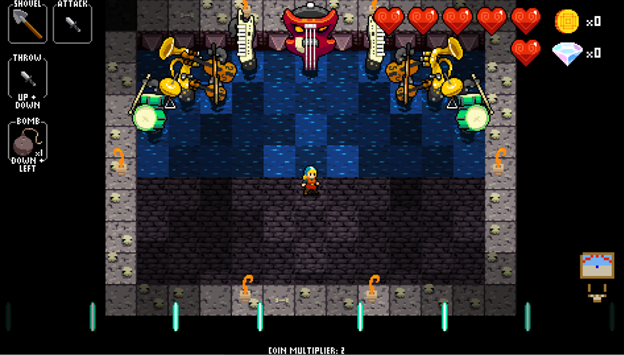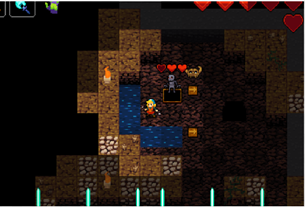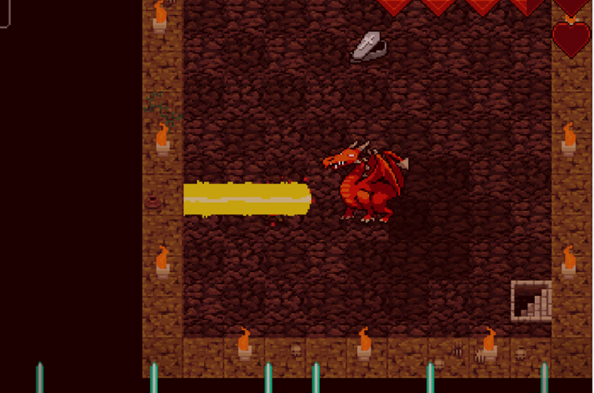Game: Crypt of the NecroDancer
Genre: (Hardcore) Roguelike dungeon, rhythm game/ 2D
Description: The player controls the protagonist Cadence to retrieve her heart that was stolen by the antagonist, the NecroDancer. On Cadence’s quest, she must travel through 4 levels, defeat various bosses and finally confront the NecroDancer. The player may only make moves with the beat of the music, using only arrow keys on the keyboard. Combat is turn based and is situated on a 2D grid.
Website: https://braceyourselfgames.com/crypt-of-the-necrodancer/
Screenshot:

Video: https://www.youtube.com/watch?v=R5198bVlANY
In my opinion, the game is generally well done, with some possible room for improvement. Probably not my most favorite game, but I believe it deserves a 8/10.
What was done well:
Elemental Tetrad: The 4 elements are well integrated. The mechanics of the game are executed with the music yet follows the rules of a roguelike dungeon game. The story is linear (and continuous for unlocked characters) and encourages the player frequently by showing part of the story whenever they progress into a new level. The story revolves around a Golden Lute, a cursed artifact that grants its wielder immense power, at the cost of their freedom (allured to play the Lute for eternity). The dungeon and the Lute are both created by a single entity that was working on necromantic experiments that involve infusing musical instruments with life, which explains the various enemies and the environment the player observes, making the game aesthetically consistent with its music theme. For example, the Minotaur carries a harp on its head like a pair of horns. The technology used was simple as the game was designed with a 2D screen experience, requiring no more than a laptop.
Minotaur image:

1. Essential Experience: Brings out the minimum axioms in both roguelike dungeon and rhythm games, yet make the combination synergistic. Requirement to follow the beat forces the player to act and plan carefully for the roguelike aspects (turn based grid movement, defeating enemies without being damaged). All enemies move/attack in a pattern specific to how they look, allowing players to gain an advantage through mastery. Bosses follow a more complex set of rules, possibly requiring the player to specially strategize to defeat them efficiently.
18. Flow: Players have a clear direction for stairs to reach and defeat the boss. Enemies gain HP and damage, attack in more complex patterns, music tempo increases with later levels, at a reasonable rate of progression. New traps are also gradually introduced. In each level, the player’s goal is to descend 3 floors by finding stairs, and defeating a boss at the end. The player is required to defeat a miniboss, a strong monster, every floor. The player is initially armed with only a dagger, having to defeat enemies with melee combat, and gradually gains access to more powerful weapons acquired through in-game currency of gems, which can be earnt from defeating bosses/finding loot in dungeons. Players also gain access to armor that generally reduce damage taken, and accessories that assist the player in various ways.
Traps can affect players, but can be also used against enemies:

55. Virtual Interface: Screen is neat, player health and items are shown above, music rhythm is shown below, visited rooms are shown on a minimap and monsters have their health shown directly above.
57. Feedback: All monsters hop when they move, and emit sounds when damaged/defeated. It makes the game alive, acting always and only with the flow of the music.
What may need improvement:
27. Skill: “Rather steep learning curve”/”may not be suitable” for most players, rules are harsh. Players get damaged easily when they miss a beat when trying to kill an enemy, or does not react to environment on time due to the fast tempo of the music. The player (and all monsters) may only make a move on each beat of the music, extra moves will be ignored, and missing a beat may be disadvantageous for the player in certain situations. Although the player can damage/defeat enemies with their dagger, they need to be careful not to get hit by monsters as these monsters move/attack in a pattern with the beat of the music as well. The game may boil down to a skill wall when the player is completely unable to cope with the new level’s enemies, or its fast music tempo, requiring the player to practice before gaining a single bit of progress.
Example (Red Dragon). This enemy has a powerful beam attack which many players may struggle to avoid:

